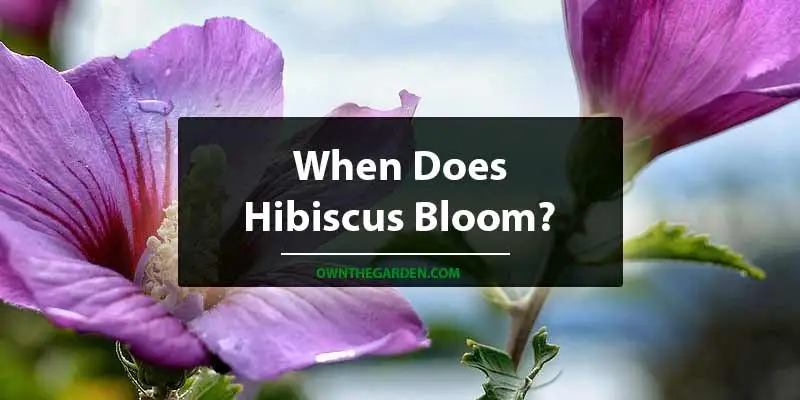Hibiscus is a beautiful and easy-to-grow perennial, but it can be challenging to determine when the plant will bloom. There are several factors that affect the blooming cycle of hibiscus plants, including climate and temperature. You need to keep an eye on these factors if you want your hibiscus to reach its full potential in terms of blooms.
In this article, we’ll take a look at what affects hibiscus blooming and how you can pinpoint when your plant will bloom so that you’re prepared for that special moment!
When Does Hibiscus Bloom?
There are many varieties of hibiscus, which means that their blooming seasons vary. Some bloom in late spring to early summer, while others bloom in fall or winter. The color of the flower depends on the variety as well as light and temperature, so you may end up with dark red flowers if your hibiscus is in a sunny spot or white flowers if it’s grown indoors with artificial lighting.
In general, though, you can expect your hibiscus to begin flowering once temperatures heat up—around April through August depending on where you live. This doesn’t mean that all species will bloom at once; some will wait until later in the season than others before putting out their blossoms!
How Long Does Hibiscus Bloom?
Hibiscus will bloom for 3-5 months. The flowers can also bloom year round, depending on the variety. Some varieties bloom in the summer, while others may bloom in fall and winter as well. For example, hibiscuses with double blooms often have their best show of flowers in warm weather when they’re full of energy and sunshine!
To make sure you get the longest-lasting blooms possible out of your hibiscus plants, be sure to water them regularly during their active growing season (the time period between when they sprout new leaves and go dormant). This will keep them healthy and happy so that they can continue filling your garden with beautiful flowers all year long!
Does Hibiscus Bloom More Than Once?
If you want more blooms, you can encourage your hibiscus to bloom again by cutting back the plant after its first bloom. This will cause it to grow new branches and flower again, though the blooms will be smaller than the first ones.
Will Hibiscus Bloom Again After Being Cut?
You can expect your hibiscus to bloom again after being cut, although it may take a few weeks. Remove any flowers from the plant that are beginning to turn brown or wilt. This will help keep your plant healthy and allow it to grow more flowers in the future.
After about a week, you can store these fresh cuts in water for another week or so before they wilt completely.
When Should I Plant Hibiscus?
Planting hibiscus is best done in spring or summer. The planting season for hibiscus is between March and May, but it can be planted at other times of the year as well. Be sure to select a spot for hibiscus that receives full sun and good drainage, as these plants do not tolerate wet feet! It’s also important to plant your hibiscus well before frost occurs so you don’t have to worry about frostbite.
- Plant in the morning or evening hours if possible, as this will help reduce stress on your plant during transplantation time. Don’t forget that you’ll need a shovel handy for digging holes and moving things around—a trowel won’t work very well here!
- After planting, water your new hibiscus thoroughly until water flows freely from its base (this may take two or three weeks depending on how dry the soil was). Once established in its new home, keep an eye on rainfall so that your plant doesn’t get too much or too little moisture throughout different seasons—you want just enough rainwater stored up inside its roots without letting them get soggy from overwatering too often (which could lead towards root rot).
Why Is My Hibiscus Not Blooming?
When it comes time for them to start blooming and you haven’t seen any yet, there are several possible reasons for that. Below are some of them:
- The plant is not getting enough sunlight. Hibiscus needs at least six hours of direct sunlight a day to bloom well. If they are growing in partial shade, they tend to produce fewer blooms than expected.
- The plant is too young, it needs to be at least a year old before blooming. Plants that were purchased as seedlings or small plants will not start blooming until they have aged for one full growing season and then put on some growth during the next one.
- The plant is not getting enough water or nutrients in its soil mix (if you are using one). When this happens, hibiscus may stop flowering altogether and even die back on the lower branches if not corrected quickly by giving the plant more water when needed and applying fertilizer or other amendments regularly throughout the growing season according to package directions on those products’ labels so that your hibiscus has what it needs for healthy foliage growth along with plenty of opportunity for blossoms later down the road when conditions finally improve once again!
Conclusion
It’s important to remember that not all hibiscus will bloom at the same time. If you have a hibiscus that is not blooming, it may be because it’s still too young or because it hasn’t been exposed to enough sunlight and heat. If your plant is still showing no signs of blooming after several weeks, then there may be something wrong with its roots or leaves which may require treatment by an expert gardener. You can also try watering more frequently during this time so that there are ample nutrients available for growth!


